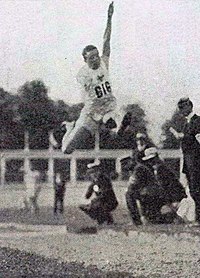Contents
| Men's long jump at the Games of the VII Olympiad | ||||||||||
|---|---|---|---|---|---|---|---|---|---|---|
 William Petersson | ||||||||||
| Venue | Olympisch Stadion | |||||||||
| Dates | August 17–18, 1920 | |||||||||
| Competitors | 29 from 11 nations | |||||||||
| Medalists | ||||||||||
| ||||||||||
| Athletics at the 1920 Summer Olympics | |
|---|---|
| | |
| Track events | |
| 100 m | men |
| 200 m | men |
| 400 m | men |
| 800 m | men |
| 1500 m | men |
| 5000 m | men |
| 10,000 m | men |
| 110 m hurdles | men |
| 400 m hurdles | men |
| 3000 m steeplechase | men |
| 4 × 100 m relay | men |
| 4 × 400 m relay | men |
| 3000 m team race | men |
| 3 km walk | men |
| 10 km walk | men |
| Road events | |
| Marathon | men |
| Field events | |
| Long jump | men |
| Triple jump | men |
| High jump | men |
| Pole vault | men |
| Shot put | men |
| Discus throw | men |
| Hammer throw | men |
| Javelin throw | men |
| 56 lb weight throw | men |
| Combined events | |
| Pentathlon | men |
| Decathlon | men |
| Cross-country events | |
| Individual | men |
| Team | men |
The men's long jump event was part of the track and field athletics programme at the 1920 Summer Olympics. The competition was held on Tuesday, August 17, 1920, and on Wednesday, August 18, 1920. 29 long jumpers from eleven nations competed. [1] No nation had more than 4 runners, suggesting the limit had been reduced from the 12 maximum in force in 1908 and 1912. The event was won by William Petersson of Sweden, the first time an athlete not from the United States took gold in the long jump.